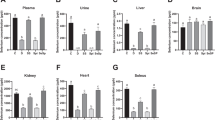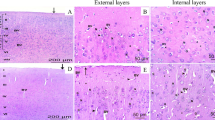Abstract
Selenium (Se) is an essential as well as a toxic trace element. Se intoxication has been reported in both livestock and humans. The central nervous system is sensitive to Se poisoning; exposure to Se causes blind staggers in cattle, poliomyelomalacia in pigs, and nervous system disorders in humans. Differences in neurotoxicity between inorganic and organic Se have been demonstrated. In this study, groups of five male BALB/c mice each were administered sodium selenite or selenomethionine in drinking water ad libitum at 0, 1, 3, and 9 ppm as Se for 14 days. At the end of Se exposure, their brains were removed and dissected into different regions. The concentration of norepinephrine (NE), dopamine (DA), dihydroxyphenylacetic acid (DOPAC), homovanillic acid (HVA), serotonin (5-HT), and 5-hydroxyindolacetic acid (5-HIAA) were determined in each brain region. Food and water consumption and body weight gain were significantly decreased in the group treated with the highest concentration of sodium selenite. In mice administered sodium selenite at 3 and 9 ppm, DOPAC was significantly higher in the striatum than in the control group. The striatal HVA was also increased in the group treated with 3 ppm Se; the DA showed a similar pattern, but the increase was not statistically significant. No alterations of NE, 5-HT, or 5-HIAA levels were detected in any brain region of mice treated with sodium selenite. No significant differences in any parameter among the groups treated with selenomethionine were observed indicating that inorganic Se was more neurotoxic than organic Se via drinking water. The alterations of DA metabolites by inorganic Se in DA-rich striatum suggested a Se-specific increased neural activity of dopaminergic pathways. Results may be useful in further elucidation of neurotoxicity of Se and in establishing a safe level of intake for this element.
Similar content being viewed by others
Author information
Authors and Affiliations
Additional information
Received: 10 September 1999/Accepted: 30 November 1999
Rights and permissions
About this article
Cite this article
Tsunoda, M., Johnson, V. & Sharma, R. Increase in Dopamine Metabolites in Murine Striatum After Oral Exposure to Inorganic But Not Organic Form of Selenium. Arch. Environ. Contam. Toxicol. 39, 32–37 (2000). https://doi.org/10.1007/s002440010076
Issue Date:
DOI: https://doi.org/10.1007/s002440010076




